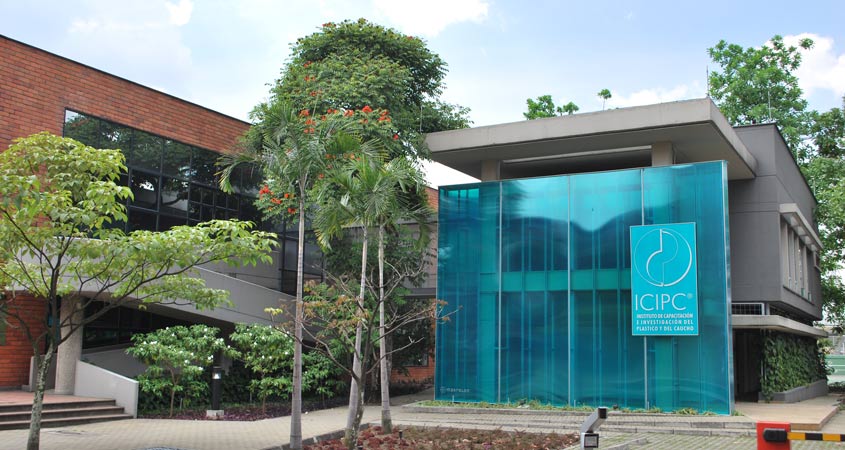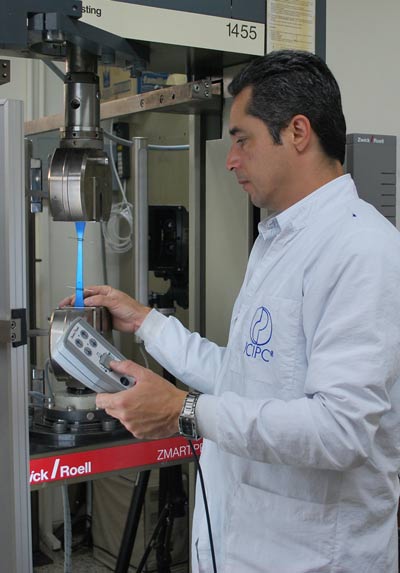
Adding fuel to Colombia’s innovation ecosystem
By María del Pilar Noriega, Director General, Laura Restrepo, Biomedical Engineer and Laura Moscoso, Lawyer, (ICIPC), Medellín, Colombia
Colombia is Latin America’s fourth-largest oil producer. As such, oil and gas have played and continue to play an important role in its economy, catalyzing the development of many downstream industries, including petrochemicals, plastics and rubber used in manufacturing an array of consumer goods.

For over two decades, Colombia’s Rubber and Plastic Institute for Training and Research (ICIPC), a non-profit technology development center, has been at the forefront of efforts to boost innovation, increase productivity and enhance the competitiveness of companies operating in the country’s plastics, rubber and associated industries. Just three years after it began operations in 1993, ICIPC partnered with COLCIENCIAS, the government’s science, technology and innovation arm, further cementing its role as a key player in Colombia’s drive to strengthen and expand its national innovation ecosystem.
ICIPC’s mission is to “convert knowledge into wealth”, and it has been widely recognized for its success in doing that for the companies it works with. Its extensive experience in generating knowledge and transferring it to the private sector offers useful insights for those engaged in developing and applying successful innovation and technology transfer practices.
ICIPC provides technology solutions to the plastics, rubber and related industries in Colombia and Latin America. To date it has worked with more than 1,200 enterprises. More than 700 of them operate in the sector and are based in Colombia’s main cities. ICIPC also undertakes state-of-the-art laboratory tests (according to ISO standards) for quality control and assurance in support of R&D and innovation projects, and training programs.

Building an effective and sustainable national innovation system is a multi-faceted, long-term and complex process involving multiple actors. Thanks to a series of political and institutional reforms in Colombia in recent years, innovation and innovative entrepreneurship are on the rise.
The government’s staunch commitment to strengthening the country’s capabilities in the area of science, technology and innovation (STI), and to ensuring that it improves people’s lives, are beginning to bear fruit. In the recently published Global Innovation Index (GII) 2016, Colombia emerged as the fifth most innovative economy in Latin America (with a global ranking of 63). But with its sights set on becoming the most innovative country in Latin America by 2025, there is still a great deal to do to expand and strengthen the national innovation ecosystem.
The overriding aims of Colombia’s innovation policy are to drive sustainable economic and social development and to improve the wellbeing of Colombians. Success will depend on upscaling the innovation system and ensuring that it responds not only to market demand, but also to social demand for innovation in areas like environmental protection, good quality housing and infrastructure for low-income communities, and improving agricultural productivity. As the world’s most biodiverse country per square meter, Colombia’s natural resources – with potential applications in health, agriculture, cosmetics and drug development – have huge potential to diversify the country’s economy and drive its development. This will involve focusing on a range of areas including:
- boosting competition and entrepreneurship;
- making more diverse support mechanisms available and targeting sectors with high growth potential;
- increasing the share of business investment in research and development (R&D) to at least 50 percent within a decade;
- skills development, especially in relation to technology transfer and intellectual property (IP);
- improving business-to-business networking;
- better access to external sources of knowledge; and
- strengthening STI institutions and improving the quality and impact of research and knowledge.
Improving technology transfer, promoting STI development as engines of business growth and entrepreneurship, and creating a culture that values and manages knowledge and innovation are central to this process. Only by building awareness among key innovation actors – in particular the private sector and research institutes, but also the general public – about the relevance of IP to their innovative activities will Colombia be able to leverage its strengths and extend them into areas with significant growth potential.

industries in Colombia and Latin America. To date it has worked with
more than 1,200 enterprises helping them to boost innovation, increase
productivity and enhance their competitiveness (photo: Courtesy of ICIPC).
For its part, since 1998 ICIPC has been working with companies across the plastics and rubber production chains in collaboration with the National Service of Apprenticeship (SENA), COLCIENCIAS and Colombia’s state-owned entrepreneurial development and export-import bank, BANCOLDEX, to enhance productivity and boost innovation in the sector. This has resulted in significant productivity gains for target companies and several product and process innovations protected by IP rights.
This work has also helped to demonstrate the practical advantages of implementing a robust IP strategy at the company level. Partnering with companies in this way is an effective means of building awareness in business circles of how IP can leverage the economic value of innovation, create new revenue streams and support business development. This is particularly important in a country where levels of IP awareness and IP filing rates are low. Such partnerships also ensure that ICIPC’s research is demand driven, has a practical application and ultimately reaches the market.
Close collaboration between research centers like ICIPC and industry is a win-win situation. It generates much-needed revenues for research centers and ensures that research remains relevant; industry benefits from new ideas and innovation and the public benefits from new and improved products and services.
The role of government
Government of course has a key role in ensuring coherence and effective coordination across the systems of STI and innovation, and COLCIENCIAS has been extremely active in this regard. But if the country is to improve its innovation performance, further investment in STI will be required, as indicated in the GII 2016 analysis. The availability of mineral royalties to fund expansion of Colombia’s innovation ecosystem – STI now receives 10 percent of such royalties – is a big opportunity, but is vulnerable to volatile mineral markets. Ideally, investment in innovation will become a permanent part of the government’s regular budget. This would guard against political short-termism and help mitigate the impact on innovation investment of declining mineral royalties.
Skills development
Improving the quality and impact of research and enabling technology transfer requires a robust system for carrying out high-quality fundamental and applied research plus the skills to transfer that knowledge to the productive sector and society in general. This, too, is an area that COLCIENCIAS and its partners are focusing on.
Despite recent improvements, Colombia’s STI outputs as traditionally measured (scientific publications, patent and trademark applications) remain well below par. Colombia has 81 universities, but only a small proportion of professors hold a PhD and those who do are concentrated in a small number of elite universities. Improving the quality and range of Colombia’s STI outputs therefore remains a tough challenge, but one that we are actively tackling.
External funding opportunities and the government’s new focus on research and innovation have boosted national production of PhDs, putting the country on track to meet its target of 3,000 PhDs by 2025. We are also seeing an emerging trend among universities to professionalize research management, as indicated by the appointment of a growing number of vice-rectors for research. Modern legislation on IP similar to the Bayh-Dole Act in the United States (see box) has also prompted the creation of technology transfer offices and other specialized functions within universities, although current employment conditions and regulations continue to hamper the creation of spin-off companies.
Skills development is an important focus for ICIPC. In association with Universidad EAFIT, the Institute runs a Program of Specialization in Plastic and Rubber Conversion Processes and a Masters in Engineering of Polymer Processing as well as various short courses, and to date has trained over 10,000 people.
About the Bayh-Dole Act
The 1980 Bayh-Dole Act (Patent and Trademark Law Amendments Act) in the United States deals with the question of ownership of inventions arising from federal government-funded research. The Act allows a university, small business, or non-profit institution to retain ownership of any invention resulting from federal funding. Prior to the Act, such inventions were assigned by obligation to the federal government but very few of them were commercially licensed. The Act facilitates technology transfer, the process of commercializing those inventions, and turning them into new products or services.
Building IP awareness
In the early 2000s, recognizing the importance of IP to the sustainability of its own business strategy, ICIPC began to actively manage its IP assets and has since acquired significant experience in IP licensing and asset management. Indeed, today IP has become the Institute’s largest asset, with more than 50 IP filings covering multiple IP rights. The Institute has also strengthened its research, development and design services, offering prior art patent searches and developing technology transfer and innovation methodologies.
ICIPC is committed to building an outward-looking research culture that is prepared to think creatively about how to tackle challenges, including ways to maintain research funding and develop a network of partnerships to expand research opportunities. As such, it is ideally placed to lead the SECOPIND IP hub, a network of 16 academic and industrial members (see box) established in 2008 with the support of COLCIENCIAS.
In this role, ICIPC is working to promote innovation and IP awareness and to facilitate technology transfer from universities and research institutes to the private sector. While large companies can access world science directly, many smaller companies can do so only by partnering with local universities and research institutes, hence the need to improve the quality of their research outputs. These institutions have a key role to play in helping companies to increase their internal innovation and IP capabilities over time. Our own experience mirrors international findings that leveraging relationships with graduates as they move into industry is a powerful way to increase the absorptive capacity of companies and to exchange knowledge. Graduates are invaluable prospective partners for future joint research and innovation projects.
Members of SECOPIND
Universidad de Antioquia, Universidad Nacional de Colombia, Universidad EAFIT, Universidad Pontificia Bolivariana, Universidad del Norte, Universidad del Valle, Institución Universitaria ITM, CIDET, CECIF, Vidarium, Ruta N, Tecnnova, Servicios Nutresa, Sumicol, Argos and ICIPC (Network Hub).
By bringing key innovation actors together, SECOPIND is able to pool resources to secure access to a range of shared specialist IP services, including for prior art patent searches, proof of concept, IP valuation and technology transfer and commercialization. The network also supports training programs and brings much-needed critical thinking to the field of IP in Colombia.
By the October 19, 2015, the SECOPIND IP network had filed 323 patent applications and the aim is for the country as a whole to file 1,000 patent applications per year by 2025. While the network boasts a rich and expanding patent portfolio, how to bring these technologies to market is proving a key challenge, as only 20 percent of them are licensed out. This, we hope, will improve as innovation and IP become more deeply embedded in Colombia’s business culture.
While expanding and strengthening Colombia’s innovation ecosystem in support of sustained economic and social development remains a complex challenge, and much still remains to be done, the future holds great promise. The country’s growth rates, its abundant natural resources, a rich pool of talent, the commitment and declared innovation goals of government and the country’s recent peace deal are all reasons for optimism.
The WIPO Magazine is intended to help broaden public understanding of intellectual property and of WIPO’s work, and is not an official document of WIPO. The designations employed and the presentation of material throughout this publication do not imply the expression of any opinion whatsoever on the part of WIPO concerning the legal status of any country, territory or area or of its authorities, or concerning the delimitation of its frontiers or boundaries. This publication is not intended to reflect the views of the Member States or the WIPO Secretariat. The mention of specific companies or products of manufacturers does not imply that they are endorsed or recommended by WIPO in preference to others of a similar nature that are not mentioned.